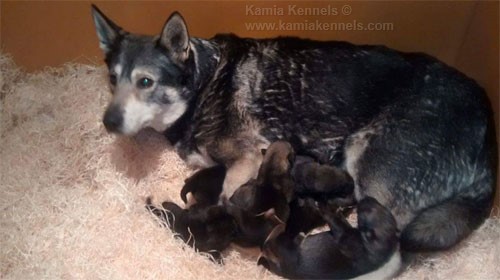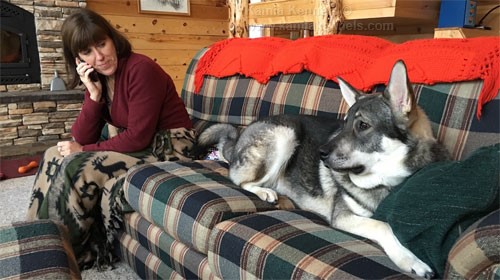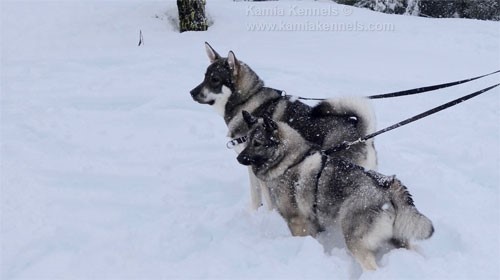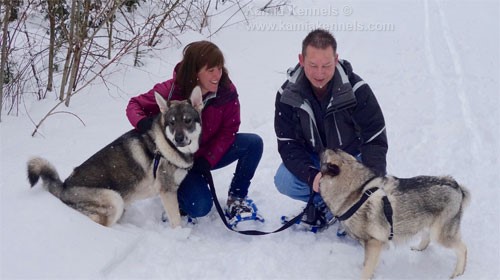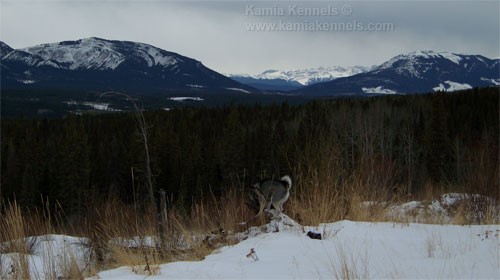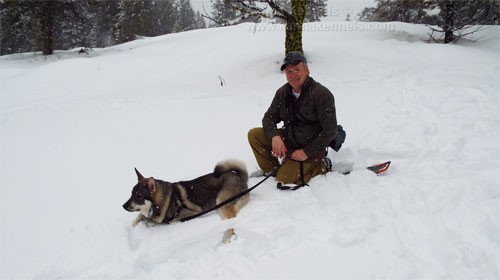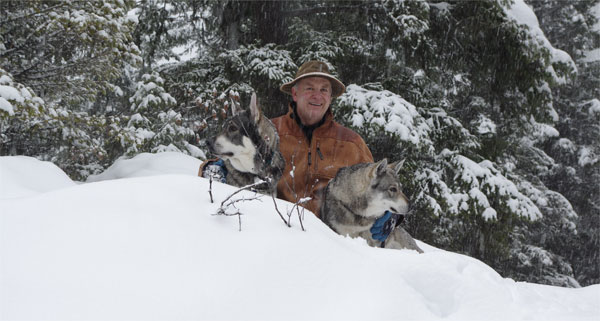Jamthund - A Majestic Dog Breed
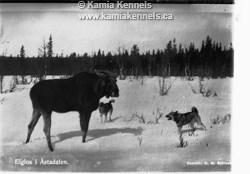 A
dog as old as the history of the free world, Jamthund’s ancestry date back
to prehistoric times when northern Sweden was colonized from the west
(Norwegian coast) and from the east (Finland). For thousands of years, they
were grouped in the same categories as Norwegian Elkhounds and Grahunds. It
wasn’t until 1946 the Jamthund was officially recognized as its own,
majestic dog breed.
A
dog as old as the history of the free world, Jamthund’s ancestry date back
to prehistoric times when northern Sweden was colonized from the west
(Norwegian coast) and from the east (Finland). For thousands of years, they
were grouped in the same categories as Norwegian Elkhounds and Grahunds. It
wasn’t until 1946 the Jamthund was officially recognized as its own,
majestic dog breed.
The breed is named after Jamtland, a district in
the middle of Sweden, situated close to the Swedish-Norwegian border. The
district spans over 50,000 square kilometers and experiences some of the
harshest Nordic weather in the world. Additionally, it’s a mountainous area
with up to 1,762 meters of mountains and widespread wood coverage. Barely
inhabited by Swedish natives throughout its history, the territory’s climate
is a testimony to how infallible, strong, and powerful Jamthunds are.
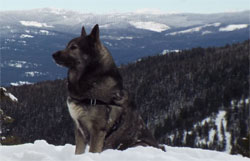 As
an independent republic during the Viking Age, this notorious territory
became the battlefield between Swedish and Danish/Norwegian kingdoms in the
16th and 17th centuries. Eventually won out by the Swedish, the ominous and
icy terrain makes for a breathtakingly beautiful, and wildlife friendly
area. From it, the Jamthund was born. A member of the Spitz family, these
hardy and insurmountable dogs are only found in the harshest of Arctic
climates around the world, like Scandinavia, Russia, and Canada. Because of
their natural climate, Jamthund’s build and coat are a product of their
environment. Their warm and thick coats are waterproof, designed to send
heavy snowfalls effortlessly rolling off their backs. Jamthund heads are
wedged shaped to withstand harsh and high-speed winds, and their flexible
and enduring gait permits them to run over rugged terrain for miles on end.
The perfect, hardy wilderness dog, Jamthunds are built to conquer the
impassable wildernesses of the Nordic world.
As
an independent republic during the Viking Age, this notorious territory
became the battlefield between Swedish and Danish/Norwegian kingdoms in the
16th and 17th centuries. Eventually won out by the Swedish, the ominous and
icy terrain makes for a breathtakingly beautiful, and wildlife friendly
area. From it, the Jamthund was born. A member of the Spitz family, these
hardy and insurmountable dogs are only found in the harshest of Arctic
climates around the world, like Scandinavia, Russia, and Canada. Because of
their natural climate, Jamthund’s build and coat are a product of their
environment. Their warm and thick coats are waterproof, designed to send
heavy snowfalls effortlessly rolling off their backs. Jamthund heads are
wedged shaped to withstand harsh and high-speed winds, and their flexible
and enduring gait permits them to run over rugged terrain for miles on end.
The perfect, hardy wilderness dog, Jamthunds are built to conquer the
impassable wildernesses of the Nordic world.
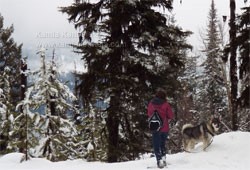 It
is important to note there are little differences between the Jamthund and
the Norwegian Elkhounds. Both undoubtedly share the same ancestry in their
early history. It is hard for historians to pinpoint the exact time when the
two breeds deviated from one another. With very minor differences notable
today, it’s incredibly hard to tell the two breeds apart. This closeness
lead to the confusion on the part of many who when the Norwegian Elkhound
Association started pre-1900 thought that all grey Elkhounds were essentially the
same, or one breed. It was common for the next 40 years or more that many referred
to both as the same, the Norwegian Elkhound.
It
is important to note there are little differences between the Jamthund and
the Norwegian Elkhounds. Both undoubtedly share the same ancestry in their
early history. It is hard for historians to pinpoint the exact time when the
two breeds deviated from one another. With very minor differences notable
today, it’s incredibly hard to tell the two breeds apart. This closeness
lead to the confusion on the part of many who when the Norwegian Elkhound
Association started pre-1900 thought that all grey Elkhounds were essentially the
same, or one breed. It was common for the next 40 years or more that many referred
to both as the same, the Norwegian Elkhound.
Only those few breeders
who put more stock in hunting abilities and lived remotely were keeping the
lineages separate and knew the differences in the two. The differences are there in the big Swedish Grey’s, they
are distinct and had been selectively bred for centuries, but this was
fading in the early 1900’s. The magnificent big Swedish Elkhounds were
becoming very hard to find. Many breeders were finding it difficult to keep
the lineage pure as the proliferation of the smaller grey, or Norwegian
Elkhound was finding it’s way into the breeding of the larger greys. Only
those old breeders, living in the harsh regions of the Jamtland province and
a few other areas still had the true big Swedish Elkhounds.
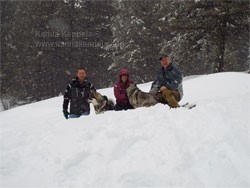 In
the timeframe around 1942, a man named Aksel Lindstrom discovered his
favorite Nordic dog breed, the Swedish Elkhound, which later became the
Jamthund, was almost extinct as only a few of his countrymen were making an
effort to distinguish the different Elkhound breeds. The Norwegian Elkhound,
or Grahund had been given all the attention, and for many, the assumption
was all the grey Elkhound were one. Aksel Lindstrom disagreed, and knew
differently. As a young boy he had witnessed many of the grand big dogs in
his homeland region. He wrote an article on the Jamthund, and received
national attention, most notably from Count Bjorn von Rosen, a celebrated
dog fancier and diplomat. Together they contacted the Swedish Spitz Dog Club
and presented their case for the Jamthund. The Club agreed the dog breed
must be saved, and that same year, the Swedish Kennel Club officially
recognized the Jamthund. It took a couple years after to sort out official
height and coat requirements for classifying a dog as either Jamthund or
Grahund, but the dog enthusiasts were able to agree on final standards by
1946.
In
the timeframe around 1942, a man named Aksel Lindstrom discovered his
favorite Nordic dog breed, the Swedish Elkhound, which later became the
Jamthund, was almost extinct as only a few of his countrymen were making an
effort to distinguish the different Elkhound breeds. The Norwegian Elkhound,
or Grahund had been given all the attention, and for many, the assumption
was all the grey Elkhound were one. Aksel Lindstrom disagreed, and knew
differently. As a young boy he had witnessed many of the grand big dogs in
his homeland region. He wrote an article on the Jamthund, and received
national attention, most notably from Count Bjorn von Rosen, a celebrated
dog fancier and diplomat. Together they contacted the Swedish Spitz Dog Club
and presented their case for the Jamthund. The Club agreed the dog breed
must be saved, and that same year, the Swedish Kennel Club officially
recognized the Jamthund. It took a couple years after to sort out official
height and coat requirements for classifying a dog as either Jamthund or
Grahund, but the dog enthusiasts were able to agree on final standards by
1946.
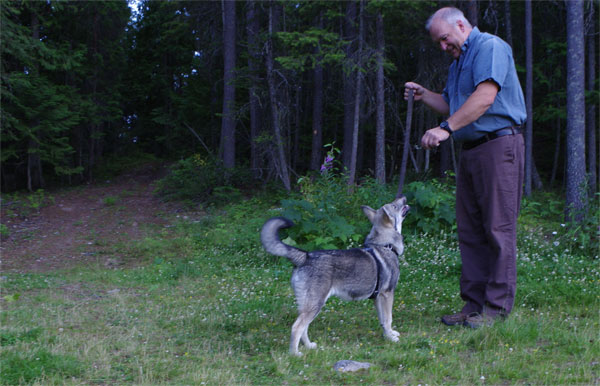
Aina - Jamthund Female 4 Months Old with Kamia Kennels Founder Merv
Carlson Click The Image To Read About Aina


